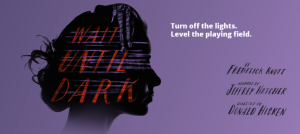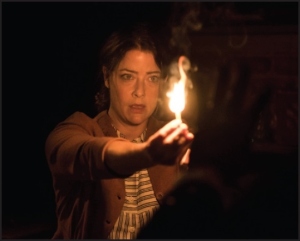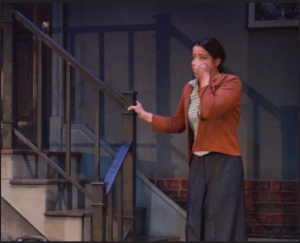
Check out the Backstage Banter for Wait Until Dark at Everyman Theatre!
“… throw in Greenwich Village, NYC in 1944 and a basement apartment and you have a fast paced, intelligent story that has you writhing in your seat and wanting to jump up on stage to yell directions to the protagonist.”
Everyman Theatre
Tag Archives: Todd Scofield
Review: Wait Until Dark at Everyman Theatre
By Jason Crawford Samios-Uy

Running Time: 2 hours with one 15-minute intermission.
I’ve always been a fan of a good thriller. The nail biting, the jumps, the wondering what’s going to happen next, the edge-of-your-seat stuff… everything! I also love it because it accelerates the heart rate and you don’t even have to step on a treadmill, and we could all use some good cardio every now and again! The latest offering and opening production of the 2016/2017 season at Everyman Theatre, Wait Until Dark by Frederick Knott, Adapted by Jeffery Hatcher, and Directed by Donald Hicken is two hours of excitement, intrigue, and entertainment that gets the heart racing and will have you leaving the theatre with shorter nails and when you walked in.

Megan Anderson as Susan. Credit: ClintonBPhotography
Wait Until Dark is cleverly crafted with a ruthless gangster-type, an ousted NYPD detective, an army buddy, a bratty neighbor girl, an absent husband, and a seemingly helpless blind housewife who are all intertwined in a deadly game of hide and seek and catch-me-if-you-can. If this isn’t intriguing enough, throw in Greenwich Village, NYC in 1944 and a basement apartment and you have a fast paced, intelligent story that has you writhing in your seat and wanting to jump up on stage to yell directions to the protagonist.
Set Design by Daniel Ettinger is authentic, very well thought-out and compliments the story beautifully. Being a unit set and a basement apartment, Ettinger uses levels and, working along with the blocking of the piece, keeps the action moving and interesting. The set was so realistic, I really felt I was looking in through the window of a 1940s apartment in Greenwich Village so Mr. Ettinger has absolutely and superbly accomplished his set designing goals.

Eric M. Messner as Mike and Megan Anderson as Susan. Credit: ClintonBPhotography
Costume Design by Ben Argenta Kress is spot on for the 1944 New York City setting and each actor’s wardrobe is seemingly researched and well though-out. Also, the costumes did not only fit the piece, the actors seemed to be very comfortable in what he or she is wearing, adding to the natural feel of the performances. From the saddle shoes of the upstairs neighbor girl to the uniform of a WWII soldier back from Italy, everything was in place and was matched impeccably with the piece.
Continuing with the technical aspect of this production, I couldn’t call this review complete without mentioning Lighting Design by Jay A. Herzog and Sound Design by Patrick Calhoun. Along with the Set Design and Costume Design, the Lights and Sound make this production a standout in current-running Baltimore theatre.

Megan Anderson as Susan. Credit: ClintonBPhotography
Many folks have different theatre tastes – traditional, minimal, spectacle, etc. – and I am more of a traditionalist, overall, but this production is truly impressive for the fact that I felt as though I was sitting in a movie theatre watching a film because of the Light and Sound Design. The cinematic feel was just want this production needed and every cue was chosen wisely.
Patrick Calhoun’s choice of incidental music and dramatic string chords were not overbearing but used seamlessly with the scenes playing out on the stage. The attention to detail is absolutely remarkable from the footsteps in the hall, the locking of doors, and the city sounds to the ticking clock, that emphasizes the suspense and has your heart beating just as loudly and in rhythm. Calhoun’s design is extraordinary and is a major part of the success of this production.
In 1967, Wait Until Dark was made into a successful film starring Audrey Hepburn, Alan Arkin, and Richard Crenna using the film noir style. The “noir” bit was a huge part in making the film successful (not to mention Miss Hepburn, of course), and this fact does not go unnoticed by Jay A. Herzog. His Lighting Design was near perfect for this production and completed the aforementioned cinematic feel of this piece. His use of lighting through the windows and through the open doors is realistic and added to the action. The prop lighting, such as lamps, flashlights, and the like fit in flawlessly, as well, adding subtle practicality to the entire production. The piece is dim, as all noir pieces are, but Herzog found a happy medium between the dark scenes and brightly lit scenes that did not take away from or hinder the action or story, but helped it along making for a very effective design.
The technical aspect of this production took this piece to the next level and Ettinger, Kress, Herzog, and Calhoun are to be commended for their impeccable technical work.
Taking the helm of this production, Director Donald Hicken’s vision for Wait Until Dark is genuine and well examined. He keeps the piece in its traditional setting, which is ideal for this piece, and his blocking keeps the actors moving through the various entrances and exits and keeps the action exciting. All of the technical and performance elements mesh together wonderfully and the tension is clearly present throughout but Hicken keeps the piece entertaining, as well, as to not overload the audience with horror and suspense. Overall, Hicken does a tremendous job in guiding this production.

Megan Anderson as Susan and Bruce Randolph Nelson as Roat. Credit: ClintonBPhotography
At a particularly intense point in this piece, there is a drag-out, knock-down fight between a couple of important characters and though the scene choreographed by Fight Choreographer Lewis Shaw is respectable and passionate, something seemed to be off kilter. Perhaps it is the unbalanced momentum of the scene that seems to be interrupted here and there, giving us spurts of extreme physicality with dark quiet in between. The entire fight scene just seemed a bit forced and not as naturally flowing as the rest of the piece. Still, it was a respectable fight scene and the intensity was definitely there, making the audience gasp and clutch the arm rests while waiting to see who the ultimate victor is.
To comment on the performance side of Wait Until Dark, I’d like to begin by stating that the entire ensemble is impressive from the supporting actors such as Arturo Tolentino who gives a strong performance as the congenial WWII veteran husband, Sam, and Todd Scofield who is a convincing gruff, weathered, and disgraced former member of the NYPD.
Tolentino is confident as the very likable, young newlywed, Sam, who isn’t going to do things for his disabled wife, but wants her to do things for herself and he’s very natural and gives a very pleasing performance.

Todd Scofield as Carlino and Eric M. Messner as Mike. Credit: ClintonBPhotography
Scofield takes on Carlino, the first character to whom we are introduced and he sets the tone nicely, giving a robust, accurate portrayal of a character he seems to truly understand.
Bruce Randolph Nelson tackles the role of the old time, tough-guy ganster, Roat. He gives a commendable performance as he not only plays the tough gangster, but has to play a mild-mannered husband, as well as an in-your-face father, all within moments of each other. The contrasts between the characters he portrays and the ease in which he portrays them is evidence of the self-assurance he conveys on stage making for a magnificent, strong performance.

Bruce Randolph Neslon as Roat. Credit: ClintonBPhotography
In this particular production, the role of Gloria, the bratty upstairs neighbor girl who “helps” her disabled downstairs neighbor, is played by two young actresses, Ui-Seng Francois and Shannon Hutchinson. I had the pleasure of experiencing the performance of Ui-Seng Francois and I was not disappointed. Francois’ performance is so authentic, I found myself actually hating this little monster and wishing she’d step out in front of a NY Transit bus every time she opens her nasty flippant mouth. So, needless to say, wishing for her unpleasant demise is a credit to her very strong performance. Also, this character’s change throughout the piece is very interesting and Francois pulls it off flawlessly and she ended up probably being my favorite character in the piece. I’m looking forward to seeing more from this young lady.
Eric M. Messner takes on the role of Mike, a jovial, friendly soldier who’s back from the war on the Italian front but, as with many things and people, never judge a book by its cover. Messner plays the complex character brilliantly and comfortably with a confidence and definite command of the stage. This character is supposed to be likeable from the beginning and Messner accomplishes this nicely with his large stature, his voice – a soothing timber and tone, his gentle mannerisms, and giving off the overall sense of security. He is likened to a gentle giant that you’d like to have around in a pinch.

Megan Anderson as Susan. Credit: ClintonBPhotography
A definite highlight of this production is Megan Anderson as Susan, the blind but independent housewife who ends up in the middle of this nerve-racking tale, who has a constitution of steel and discovers exactly how strong she can be despite her disability. Portraying a character with any disability is a challenge for any actor, but Anderson pulls it off flawlessly and authentically. She does not falter or drop her “blindness” at any moment in the production and her dedication and understanding not only of the disability of this character, but of the character herself is clear in superb performance. Her transition from the poor blind woman we feel sorry for to strong blind woman we’re rooting for is gradual, realistic, and seamless. She is an absolute joy to watch and her command of the stage makes for a solid and worthy performance.
Final thought… Wait Until Dark is a suspenseful and extremely entertaining show that will raise your heart rate, have you biting your nails wondering who is friend and who is foe, and rooting for the assumed underdog. It definitely has all the requirements for a good thriller with a twisting story and very talented cast that will have you on the edge of your seat from beginning to end.
This is what I thought of this production of Wait Until Dark.… what do you think?
Wait Until Dark will play through October 9 at Everyman Theatre, 315 W. Fayette Street, Baltimore, MD 21201. For tickets, call the box office at 410-752-2208 or purchase them online.
